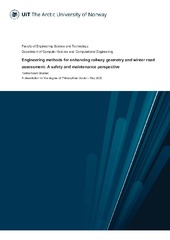Geometric Modeling- and Sensor Technology Applications for Engineering Problems
Permanent lenke
https://hdl.handle.net/10037/19546Dato
2020-10-20Type
Doctoral thesisDoktorgradsavhandling
Forfatter
Pedersen, AleksanderSammendrag
Har del(er)
Paper A: Pedersen A., Bratlie J. & Dalmo R. (2015). Spline Representation of Connected Surfaces with Custom-Shaped Holes. In: Lirkov I., Margenov S. & Waśniewski J. (Eds), Large-Scale Scientific Computing. LSSC 2015. Lecture Notes in Computer Science, vol 9374 (pp. 394-400). Springer. Also available at https://doi.org/10.1007/978-3-319-26520-9_44.
Paper B: Pedersen, A., Brustad, T.F., Bang, B. & Dalmo, R. (2019). Alternative representation of railway track geometry. Proceedings of the International Heavy Haul Association STS Conference, 12-14 June 2019, Narvik, Norway. Also available at https://ihha.net/resources-ihha/jixbvqzuiwcixuc59f7vwo7xsw9mie.
Paper C: Pedersen, A. Geometrical approach to a simple pendulum motion in 3D for large initial angles. (Submitted manuscript).
Paper D1: Pedersen, A., Bratlie, J. & Dalmo, R. (2014). Surface hole modeling using blending splines [Conference presentation abstract]. Multiphysics, 11-12 December 2014, Sofia, Bulgaria.
Paper D2: Pedersen, A. (2016). Arbitrary holes in surfaces using blending type spline constructions [Conference presentation abstract]. 9th International Conference on Mathematical Methods for Curves and Surfaces, 23-28 June 2016, Tønsberg, Norway.
Paper D3: Pedersen, A. (2018). Terrain level curves using blending splines. [Conference presentation abstract]. 9th International Conference on Curves and Surfaces, 28 June - 4 July 4 2018, Arcachon, France.
Paper E: Pedersen, A., Brustad, T.F. & Bang, B. Targeted sanding and its impact on heavy hauler pull force and surface friction. (Submitted manuscript).
Paper F: Pedersen, A. (2020). Altering perceptions, visualizing sub-ground metal objects. Emerging Science Journal, 4(3), 205-213. Also available at https://doi.org/10.28991/esj-2020-01224.
Paper G: Pedersen, A. & Brustad, T.F. (2020). A Study on Hybrid Sensor Technology in Winter Road Assessment. Safety, 6(1), 17. Also available in Munin at https://hdl.handle.net/10037/18368.
Forlag
UiT Norges arktiske universitetUiT The Arctic University of Norway
Metadata
Vis full innførselFølgende lisensfil er knyttet til denne innførselen:
Relaterte innførsler
Viser innførsler relatert til tittel, forfatter og emneord.
-
Implementing an electronic health record in a Nigerian secondary healthcare facility. Prospects and challenges
Attah, Ambrose Ojadale (Master thesis; Mastergradsoppgave, 2017-11-02)Nigeria is witnessing continuing advocacy and increase in number of individuals yearning for computerization of health information and healthcare processes. However, little is known about the opinions of the diverse healthcare providers who would ensure the successful implementation and meaningful use of health information technology in the country (Adeleke, Erinle et al. 2015). This study explores ... -
Engineering methods for enhancing railway geometry and winter road assessment: A safety and maintenance perspective
Brustad, Tanita Fossli (Doctoral thesis; Doktorgradsavhandling, 2020-06-22)In many areas around the world there are limited transportation possibilities when travelling between key cities. If these areas also experience demanding weather conditions or geography, getting from A to B, during difficult conditions, is usually not optimal in regards to accessibility, safety, and comfort. Under challenging conditions, two essential elements in strengthening accessibility, safety, ... -
Latency Optimized Microservice Architecture for Privacy Preserving Computing
Magnussen, Nikolai Åsen (Master thesis; Mastergradsoppgave, 2019-06-01)Recent developments in microservices architecture and building have lead to the advent of unikernels, a specialized operating system kernel coupled with, and executing only, a single application. This thesis presents PPCE a distributed system utilising a microservices architecture based on unikernels, created to enable privacy-preserving computing for users, classes of users, and more importantly; ...


 English
English norsk
norsk



